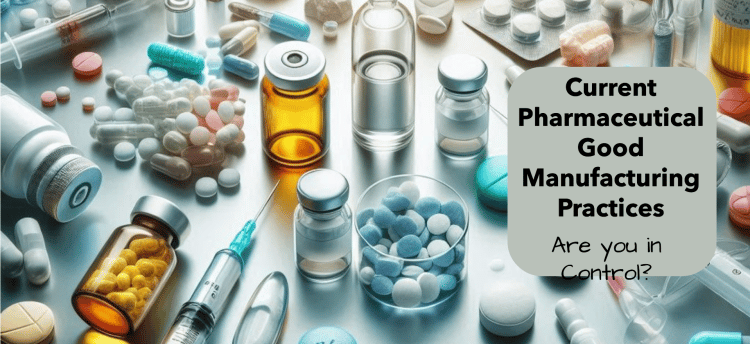Pharmaceutical cGMP and the Latest Buzzword: Control
Muhammad Tahir Iqbal X-Atco, X-BF Biosciences, X-Sanofi
10/25/20244 min read


Muhammad Tahir Iqbal
X-Atco, X-BF Biosciences, X-Sanofi
October 21, 2024
The current focus in pharmaceutical cGMP is on “Control”, as in: “Is the manufacturer in control of their processes?” This builds on the previous key concepts of the “lifecycle approach” and “risk management”, both of which emphasize a continuous, systematic method for ensuring product quality. Control is more than a new term; it encapsulates a shift in regulatory expectations, aligning with guidance set forth by ICH Q10 (Pharmaceutical Quality System), Eudralex Volume 4, WHO TRS 986, Annex 2, and PIC/S Guide PE 009-14. This broader system-driven approach mandates that, to produce quality products consistently, the manufacturer must maintain control at every stage of production.
While every manufacturer may claim control over their processes, demonstrating compliance with this assertion remains a challenge. Many in the industry are still transitioning from outdated practices—such as the reliance on “three validation batches”—to the modern, risk-based framework emphasized by current regulations.
Moving Beyond Fixed Validation Approaches
In the past, demonstrating process control often revolved around fixed concepts, such as executing three consecutive batches for process validation or media fills. However, regulations have evolved significantly, notably with the introduction of ICH Q8 (Pharmaceutical Development) and the integration of ICH Q9 (Quality Risk Management). Today, validation must go beyond fixed numbers. Manufacturers are required to implement comprehensive risk assessments at each stage of production, ensuring that processes are continually monitored and adjusted based on scientific and risk-based principles. This marks a significant departure from outdated paradigms.
Upper management must recognize the transformative potential of properly executed risk management, which is mandated by all major regulatory frameworks. Contrary to the belief that risk management is merely a checkbox exercise, it is a powerful tool for optimizing processes, reducing errors, and ensuring continuous compliance.
The Concept of Control
The concept of "Control" aligns all existing regulations under one cohesive framework. It demands that manufacturers:
1) Identify Critical Quality Attributes (CQAs).
2) Identify Critical Process Parameters (CPPs) using risk management techniques, as defined by ICH Q9.
3) Develop and qualify process equipment in accordance with Eudralex Annex 15.
4) Conduct Process Performance Qualification (PPQ) to validate that CPPs are appropriately controlled.
5) Initiate Continuous Process Verification (CPV), as required by the FDA’s Process Validation Guidance, to ensure ongoing process control.
6) Validate analytical methods to ensure that CQAs are consistently met through the use of Analytical Target Profiles (ATPs), in line with ICH Q8.
7) Implement ongoing Analytical Verification to monitor the performance of analytical methods over time.
8) Conduct regular Product Quality Reviews (PQRs), as mandated by Eudralex Volume 4, to proactively assess and adjust processes when needed.
These elements create a robust control strategy that integrates all critical aspects of the manufacturing process and ensures that quality is not only maintained but proactively managed. Where current practices differ from historical approaches is in the emphasis on detailed risk management beyond process validation. Each CPP must be clearly delineated, validated, and reassessed as needed. Multiple tests may be required to ensure control over each parameter, and analytical variations must be challenged through continuous verification processes.
Lifecycle Management and Continuous Improvement
Once the validation activities are completed, lifecycle management becomes crucial. This approach, strongly endorsed by ICH Q10, mandates that every batch and test must be tracked through trend analysis to detect deviations from the validated process in real-time. The aim is to identify potential quality issues before they affect product quality, thereby preventing failures rather than reacting to them. This requires performing Product Quality Reviews (PQRs) on a frequent basis (preferably on a batch-by-batch level), as stipulated by Eudralex Volume 4 and PIC/S PE 009-14.
Moreover, lifecycle management must extend to all aspects of production, including preventive maintenance and calibration. In line with Eudralex Annex 15 and WHO TRS 996, a well-documented preventive maintenance program must be implemented, ensuring that equipment consistently operates within its acceptable range. Calibration of critical instruments should be commensurate with the impact they have on the product, with high-risk equipment requiring more rigorous calibration and hysteresis analysis.
Data Integrity and ALCOA++ Principles
Another key aspect of control is ensuring data integrity. In a highly regulated environment, maintaining the integrity of manufacturing and analytical data is critical. The ALCOA++ principles, which demand that data must be Attributable, Legible, Contemporaneous, Original, and Accurate, have now been expanded to include requirements for data to be Complete, Consistent, Enduring, and Available. Compliance with these principles is essential to demonstrate that the manufacturer remains in control of the product quality at all times.
Both Eudralex Annex 11 and PIC/S PE 009-14 highlight the need for computerized systems to comply with these data integrity requirements. Manufacturers must ensure that their systems are validated and that data is protected from unauthorized access, tampering, or loss. In this regard, periodic data reviews and audits are necessary to confirm compliance with cGMP standards.
Conclusion
The pharmaceutical industry’s shift toward a lifecycle-based approach to process control is transforming how manufacturers manage quality. By adopting the principles of control outlined in ICH Q10, Eudralex Volume 4, WHO TRS 986, and PIC/S PE 009-14, companies can ensure that they are not merely meeting minimum regulatory requirements but are driving continuous improvement. This proactive approach minimizes risks, reduces the potential for product failures, and ultimately ensures the delivery of high-quality products to patients.
To remain competitive and compliant in this evolving regulatory landscape, manufacturers must fully embrace risk management, continuous process verification, and data integrity. These elements are the foundation of a modern pharmaceutical quality system and are critical to demonstrating control over product quality in today’s industry.
World Health Organization Official LinkedIn Account of the Pharmaceutical Inspection Co-operation Scheme (PIC/S) European Medicines Agency #pharmaceuticals #QualityProducts #Control #QualityRiskManagement
